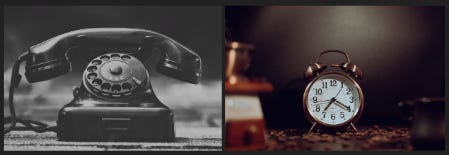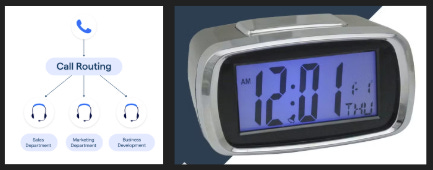Artificial Intelligence (AI) is a topic of popular discussion. In fact, the New York Times published 8 articles on AI yesterday alone! Some sources suggest that more than 10,000 AI tools exist to assist people with tasks ranging from the mundane (e.g., finding a dinner spot) to life-threatening (e.g., an AI tool that diagnoses genetic disorders). Although AI has been around for more than 60 years (Buchanan, 2005), it’s now integrated into the fabric of our lives. Despite its prominence, most people do not know what AI is or how it works (Selwyn & Cordoba, 2022).
Do you know what AI is? Take a quiz to test your knowledge,
then finish reading to learn more!
The technologies we interact with can be labeled as machines, automated systems, or AI systems. Today, we’re going to discuss the differences between these types of technologies using examples you are probably familiar with: phones and alarm clocks.
Machines
You are probably familiar with machines. Machines are technologies that operate only when humans control them. For example, a rotary phone calls people only when you dial them. If you dial the wrong number, it will call the wrong person. It doesn’t attempt to change or alter the number you enter and will perform the task exactly as you request.
Similarly, a wind-up alarm clock is a machine. It wakes you only when you set it. If you forget to set it, it will not wake you up. If you set it to the wrong time, it will wake you up at the wrong time. It doesn’t attempt to change or alter the time for which you set the alarm.
Automated Systems
Automated systems are machines that operate without human assistance by following human-set rules (for a review, see Wang & Siau, 2019). The call routing system you hear when you dial a business is an automated system. It follows a set of rules to decide whether and when to let you speak with an employee. For example, a call routing system may follow these rules:
if the caller presses 1, play the store hours recording.
if the caller presses 2, pass the call to the customer service desk.
A programmable alarm clock is another example of an automated system. A programmable alarm clock follows a set of rules to decide whether and when to wake you up. I like to wake up at 6 am on weekdays and 5:30 am on Sunday mornings. My programmable alarm clock follows these rules:
if it is a weekday, sound the alarm at 6:00 am.
if it is Saturday, do not sound the alarm.
If it is Sunday, sound the alarm at 5:30 am.
Automated systems require less oversight and control than a machine because we can “set ‘em and forget ‘em.” However, humans still retain a great deal of oversight in that we choose which rules the system follows.
AI Systems
AI systems gather the information to write their own rules, and can do so with or without human assistance. AI systems also track this information - and your response to their actions - over time to “learn” and modify their self-written rules (for a review, see Wang & Siau, 2019). Your cell phone probably features phone number autocomplete, an AI feature. Phone number autocomplete uses information, like the time of day and your location, to make predictions about who you want to call. For example, I tend to call my parents after I wake up at home on Saturday morning. The AI system on my phone has used this information about my location, the day of the week, the time of day, and my known contacts to write its own rule:
If it is Saturday morning, and the caller dials from their
home location, autocomplete with their parents’ number.
If my parents and I regularly rescheduled our calls for Sundays, the AI system would recognize this change in my dialing patterns and rewrite its rule:
If it is Sunday morning, and the caller dials from their
home location, autocomplete with their parents’ number.
Similarly, some alarm clocks include a “smart” feature that wakes you up during the lightest stage of sleep. The AI systems embedded in these alarm clocks may use sensors, like a ring on your finger, to monitor your body’s heart rate and movement during sleep. It uses these measurements to make predictions about when to wake you up. When it senses the signs of lighter sleep (e.g, faster heart rate; greater movement) during your preferred wake-up time (e.g., between 5 am and 6 am), it will sound an alarm. If your sleeping patterns change, the AI system will adjust your alarm to a different time within your preferred wake-up window.
Although AI systems can operate without human control, this does not mean that they are without human oversight. Humans design AI systems, meaning that they:
choose the data and algorithms used in rule-making;
set restrictions on how rules are carried out; and
decide which behaviors are rewarded and which are punished (Tsamados et al., 2025).
The design and management of AI systems is a topic for another post. Still, by reflecting on these points, we can reveal the capacity and limitations of human control over AI systems. As you interact with technology, it is worthwhile to consider: Who was this technology designed for? I look forward to returning to this topic in a different post!
Continue the Journey
Want to test your knowledge of the topics featured in this article? Take our five-question quiz!
Want to support more blog posts, practice questions, and featured content? Buy me a coffee.




